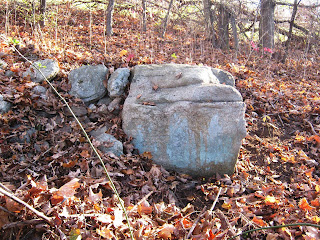How many early
New England histories begin with the comments about the Indigenous fire-tended
landscape? How fire-proof is a "stone wall?" How protective, and in
how many ways, are those ecological-zones surrounded by, when you look closely,
Serpent Effigies made of smaller stone effigies, smaller effigies still making
minor adjustments and maintaining hundreds of thousands of rows of stones still
visible on the landscape?
"By the Law of Parsimony," asks my friend Sherlock Stones, "who was more likely to have had the time and motivation to build those rows of stones - Indigenous People over thousands of years or Post Contact predominately European agriculturalists over barely three hundred??"
"By the Law of Parsimony," asks my friend Sherlock Stones, "who was more likely to have had the time and motivation to build those rows of stones - Indigenous People over thousands of years or Post Contact predominately European agriculturalists over barely three hundred??"
Brian Jones, the
Connecticut State Archaeologist: “New England was settled 13,000 years
ago...(t)he post-colonial period in New England, from 1620 to the present,
represents only 3% of this time span...97% of the (human) history of southern
New England seems to be missing...”
The “Golden Age
of Stone Wall Building” is focused on an even smaller time frame, the end of
the American Revolutionary War for Independence up to about 1875 when barbed
wire was invented, a brief window of about 100 years, here in what is now known
as New England. LiDar is being used to investigate these thousands and
thousands of rows of stones thought to be evidence of farmsteads of the
post-colonial time period:
For example: “This
is an ongoing research project to understand how people have shaped the history
and development of southern New England’s landscape. Although the landscape
reached the height of agricultural use in the early 19th century, much of that
land has now become reforested, obscuring cultural features beneath the forest.
LiDAR allows us to identify and analyze cultural landscape features and
interpret them within a broader historical, geographical, and archaeological
context to understand the human impact on the landscape’s history and
development.”
"An imaginative investigator might just
take some time to consider what Brian Jones has written above," says Sherlock, "especially
concerning the “wild foods” harvested by “hunter-gathers. That sustainable system of subsistence may be the actual "height of agricultural use," rather than the destructive practices of 19th century agriculture.” Add the practice of
burning the landscape to promote productivity of the plants, which promotes the
growth of animal and human populations. An imaginative researcher might look
for cultural clues in the stonework, learn to observe the snakes and turtles, as
well as all the other Native American Iconography contained in those Ceremonial
Stone Landscape features whose beauty, once you learn to see it, is so much
more than mere “disposal of field clearing stones.”
I’ve delved a little into a few places where
I have acquired LiDar images, field checking and making observations here and
there.
If I am looking at zigzag rows of stones, I need to wonder why does it suddenly stop being an accumulation of field clearing stones against a wooden Snake Fence, as every stone wall book will tell you - then suddenly turn linear, supposedly stones tossed under a cross and rail fence??
What if the stone wall ends in a snake head-like stone
(that teeny tiny white dot on can barely see in inset above)???
Perhaps I should say:
"If it begins with a stone that could be said to resemble a snake head...
Grinning Shape-Shifter Great Serpent:
The "backbone" of the hillside, not many steps away:
More Serpent Overlays here:
Another row of stones, also visible in the LiDar image:
It is sometimes difficult to get good details and I wish this place came through clearer:
Publications related to this (UCONN) project:
Johnson, K.M. and Ouimet, W.B.. 2016. Physical
properties and spatial controls of stone walls in the northeastern USA:
Implications for Anthropocene studies of 17th to early 20th century agriculture. Anthropocene 15:
22-36.
Johnson, K.M. and Ouimet, W.B.. 2014. Rediscovering
the lost archaeological landscape of southern New England using airborne Light
Detection and Ranging (LiDAR). Journal of Archaeological Science 43:
9-20. (Citations)(Altmetric Score)
Photo:
from:












Can the LiDar be used effectively? Is the problem the method in how it is used and the subsequent interpretation derived from its use?
ReplyDelete